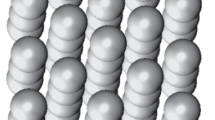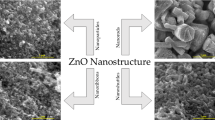Abstract
The majority of unusual properties of semiconductor nanoparticles arise both from quantum confinement effects or from surfaces effects. While the first one is reasonably well understood, very little is known about the effects of the surfaces on these nanostructures. In this manuscript, we have analyzed, by using ab initio methods based on the density functional theory, the structural modifications on the surfaces of ZnO nanoparticles smaller than 2 nm. We have observed a decrease in the bond distance between Zn and O atoms nearby the surface, and also a tendency for larger bond angles at these surfaces. This occurs to reduce the surface energy due to the presence of surface dangling bonds at the surfaces. These results should be important to help analyze experimental results.




Similar content being viewed by others
References
Arantes JT, da Silva AJR, Fazzio A (2007) Structural, electronic, and magnetic properties of Mn-doped Ge nanowires by ab initio calculations. Phys Rev B 75:115113
Berrettini MG, Braun G, Hu JG, Strouse GF (2004) NMR analysis of surfaces and interfaces in 2-nm CdSe. J Am Chem Soc 126:7063–7070
Blochl PE (1994) Projector augmented-wave method. Phys Rev B 50:17953–17979
Chang LY, Barnard AS, Gontard LC, Dunin-Borkowski RE (2010) Resolving the structure of active sites on platinum catalytic nanoparticles. Nano Lett 10:3073–3076
Chelikowsky JR, Alemany MMG, Chan TL, Dalpian GM (2011) Computational studies of doped nanostructures. Rep Prog Phys 74:046501
Claeyssens F, Freeman CL, Allan NL, Sun Y, Ashfold MNR, Harding JH (2005) Growth of ZnO thin films? Experiment and theory. J Mater Chem 15:139–148
Clift MJD, Rothen-Rutishauser B, Brown DM, Duffin R, Donaldson K, Proudfoot L, Guy K, Stone V (2008) The impact of different nanoparticle surface chemistry and size on uptake and toxicity in a murine macrophage cell line. Toxicol Appl Pharmacol 232:418–427
Freeman CL, Claeyssens F, Allan NL (2006) Graphitic nanofilms as precursors to wurtzite films: theory. Phys Rev Lett 96:066102
Galland C, Ghosh Y, Steinbrück A, Sykora M, Hollingsworth JA, Klimov VI, Htoon H (2011) Two types of luminescence blinking revealed by spectroelectrochemistry of single quantum dots. Nat Biotechnol 479:203–207
Han P, Bester G (2012) Insights about the surface of colloidal nanoclusters from their vibrational and thermodynamic properties. J Phys Chem C 116:10790–10795
Hohenberg P, Kohn W (1964) Inhomogeneous electron gas. Phys Rev 136:B864–B871
Huang X, Lindgren E, Chelikowsky JR (2005) Surface passivation method for semiconductor nanostructures. Phys Rev B 71:165328
Huxter VM, Lee A, Lo SS, Scholes GD (2008) CdSe nanoparticle elasticity and surface energy. Nano Lett 9:405–409
Kohn W, Sham LJ (1965) Self-consistent equations including exchange and correlation effects. Phys Rev 140:A1133–A1138
Kresse G, Furthmüller J (1996) Efficient iterative schemes for ab initio total-energy calculations using a plane-wave basis set. Phys Rev B 54:11169–11186
Puzder A, Williamson AJ, Gygi F, Galli G (2004) Self-healing of CdSe nanocrystals: first-principles calculations. Phys Rev Lett 92:217401
Schoenhalz AL, Arantes JT, Fazzio A, Dalpian GM (2009) Surface magnetization in non-doped ZnO nanostructures. Appl Phys Lett 94:162503
Schoenhalz AL, Arantes JT, Fazzio A, Dalpian GM (2010) Surface and quantum confinement effects in ZnO nanocrystals. J Phys Chem C 114:18293–18297
Tomaselli M, Yarger JL, Bruchez M, Havlin RH, deGraw D, Pines A, Alivisatos AP (1999) NMR study of InP quantum dots: surface structure and size effects. J Chem Phys 110:8861–8864
Tusche C, Meyerheim HL, Kirschner J (2007) Observation of depolarized ZnO(0001) monolayers: formation of unreconstructed planar sheets. Phys Rev Lett 99:026102
Viswanatha R, Sapra S, Satpati B, Satyam PV, Dev BN, Sarma DD (2004) Understanding the quantum size effects in ZnO nanocrystals. J Mater Chem 14:661–668
Yu H, Li J, Loomis RA, Wang LW, Buhro WE (2003) Two- versus three-dimensional quantum confinement in indium phosphide wires and dots. Nat Mater 2:517–520
Acknowledgments
This study was supported, in part, by Brazilian agencies CAPES, FAPESP, and CNPq. We thank CENAPAD-SP for computational support.
Author information
Authors and Affiliations
Corresponding author
Additional information
This article is part of the topical collection on nanomaterials in energy, health and environment
Rights and permissions
About this article
Cite this article
Schoenhalz, A.L., Dalpian, G.M. Surface-induced structural modification in ZnO nanoparticles. J Nanopart Res 14, 1162 (2012). https://doi.org/10.1007/s11051-012-1162-4
Received:
Accepted:
Published:
DOI: https://doi.org/10.1007/s11051-012-1162-4




